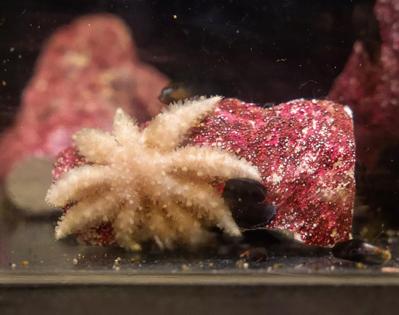Researchers figure out what's caused devastating sea star epidemic
Published in News & Features
LOS ANGELES — A study published Monday offers long-awaited clarity on a more than decade-long marine mystery: What has been killing the sunflower sea star?
In 2013, something began ravaging sea stars along the West Coast, turning them into decaying, fragmented carcasses. Over the next few years, the wasting disease (SSWD) killed billions of animals along the shore, transforming entire marine ecosystems.
One species was hit especially hard: Pycnopodia helianthoides, more commonly known as the sunflower sea star. Scientists estimate the global population plummeted by 94% since 2013. California alone lost about 99% of its sunflower sea stars. For over a decade, nobody knew what was responsible.
In their paper in Nature Ecology & Evolution, researchers have now identified the culprit behind the devastating epidemic — and with it, a path forward for restoration.
“This was a big deal for us,” said Alyssa Gehman, a marine disease ecologist at Hakai Institute and the University of British Columbia and senior author on the study. “When we started these experiments, I knew we would learn more, but I honestly wasn’t convinced we would actually find the causative agent of disease.”
The breakthrough came during a routine meeting between Gehman and two collaborators, Grace Crandall and Melanie Prentice. They had recently tested whether heat-treated coelomic fluid — the internal body fluid of a sea star — could still trigger the disease when injected into a healthy sea star. When the injected sea stars stayed healthy, it confirmed that the disease was being caused by something that was alive.
To find out what that “something” was, the team turned to a set of techniques that reveals which genes are being expressed by what microorganisms. When they compared healthy and infected animals, one group consistently stood out—the Vibrios, a type of bacteria commonly found in marine environments.
Knowing there are many Vibrios, the researchers were curious whether the wasting sickness could be tied to one in particular. Prentice ran the species-level analysis, and the result floored them.
“The whole list was Vibrio pectinocida. And it was in all of our six stars and it was in none of our controls,” Gehman said. It was “mind-blowingly clear” that this bacteria was causing the disease, she said.
For California’s kelp forests, and the conservation groups trying to save them, this news is a major turning point.
Sunflower sea stars are considered a keystone species, meaning they are critical in regulating the stability and diversity of their ecosystems. One of their most important roles is controlling purple sea urchin populations, a species with a notoriously voracious appetite.
“They can mow down a kelp forest and then actually remain in that ecosystem without a food source,” said Prentice, a marine biologist and study co-author. “They enter almost like a zombie state until the kelp regrows — and then they eradicate it again.”
Sunflower sea stars used to prey on the urchins, keeping their population in check. However, when wasting disease effectively wiped out their main predator, the sea urchins exploded in number, decimating kelp forests and transforming once-lush underwater habitats into so-called “urchin barrens.”
“Kelp forests are the most important ecosystem on our coast because they house over 800 species of animals,” said Nancy Caruso, marine biologist and founder of the nonprofit Get Inspired. “Essentially, they’re the condos and apartment complexes of the animals that live on our coastline — and when they disappear, they have no place to live.”
Kelp forests also filter water, store carbon, and protect coastal communities from storms and erosion, making them, as Prentice described, “an ally in our fight against the climate crisis.”
Since the 2013 outbreak, areas like Northern California have lost more than 95% of their kelp forest cover. Several sites are still considered ecological collapse zones.
Researchers say recovery can now be more targeted.
Prentice is currently developing a diagnostic test similar to a COVID rapid test, which could help screen animals and seawater for the presence of Vibrio pectinocida before conservationists reintroduce sea stars into the wild.
“That’s going to be powerful not just for research, but for management,” she said. “Now we can actually test animals before we move them — or test the water at a potential outplanting site and say, is this a good place for reintroduction?”
Other teams are looking at breeding disease-resistant sea stars. Surviving populations may have natural immunity, which could help shape more resilient captive-rearing programs.
At the Aquarium of the Pacific in Long Beach, which cares for some of the surviving sunflower stars, the new findings could help reshape priorities.
“It sharpens our focus on what it might take to reintroduce these animals in a way that is thoughtful, informed, and sustainable,” said Johnathan Casey, the aquarium’s curator of fish and invertebrates.
“With each new piece of the puzzle, we feel we’re getting closer to a future where sunflower stars can once again thrive along our coastline.”
Sunflower sea stars used to be everywhere — on sand, rocks, kelp beds, and seagrass beds. For Gehman, that’s the point. She hopes the findings help people realize that even the most abundant species can disappear very quickly.
©2025 Los Angeles Times. Visit at latimes.com. Distributed by Tribune Content Agency, LLC.







Comments